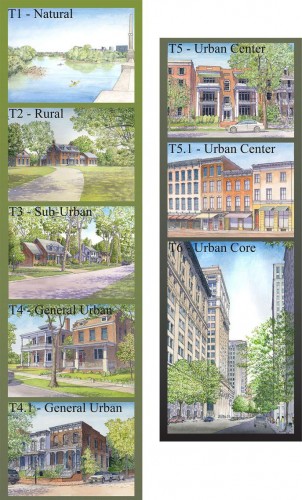The city of Indianapolis uses a comprehensive plan and zoning ordinances as their main tool of city planning (see current zoning codes; or see Indy’s zoning synopsis). The purpose of our zoning code is to resolve conflicts between land uses by separating them (Euclidean style). Obviously, there are some land uses that don’t fit well together. A quick example would be an adult entertainment venue next to an elementary school. Nobody thinks that these activities belong next to each other, so the natural solution is to just keep them separated by a healthy distance.

The problem is that conflict resolution solely by separating land uses is a bad way to run a city. When land is abundant and cheap, such as in suburban or rural areas, developers can just move a little further down the line. But in dense cities, and cities trying to become more dense, land is no longer a commodity. It is a precious resource.

In this case, conflict resolution by separation is not the best choice. Cities have begun to realize what every schoolteacher already knows – teaching people to share is a better solution. Critics of zoning have found the following problems with conventional zoning ordinances:
- it is a favorite tool of NIMBY-ism; high density projects are often thrown out in the rezoning process
- it can be used to block lower-income residents from finding jobs and affordable housing in good neighborhoods
- it turns the traditional, compact American neighborhood into an illegal form of development
- it forces sprawl by preventing co-location of compatible uses, by forcing unpopular uses to the outer fringe of cities, by spreading buildings apart, and by mandating minimum parking requirements
- it prevents the evolution of dense neighborhoods because the initial low density land uses mandated by the code cannot be reconfigured without a huge investment or legal challenge
The worst failure of zoning, and all of our city planning in fact, may be that it does not prevent our worst nightmares: an ugly building next door with lots of new auto traffic. I believe a major reform is necessary.
The New Urbanists have a solution to this zoning problem, and it’s called Form Based Codes. In fact, Duany/Plater-Zyberk have cooked up a freely available template that any city can use as an alternative process, it is called SMARTCODE. Based on Smart Growth neighborhood principles, it’s an easy way for cities to get what they want from the zoning process without spending a decade rewriting their own codes.

(image source)
Several US cities such as Miama, FL, Petaluma, CA, and Montgomery, AL, have enacted Smartcodes, and there are add-on modules for issues such as sustainability, light pollution, and other problems that can be addressed by zoning. Form based codes may be Indy’s best shot at getting good urban design in areas surrounding the central canal or Lucas Oil Stadium. Form based codes would be a great way for Indianapolis to regulate zoning in way that makes city planning possible and maximizes the benefit from public investment in our urban spaces.
The concept of an alternate compliance method is not new for Indianapolis. In fact, the Sustainable Infrastructure Initiative is working great for Indy’s Office of Sustainability. Because of this alternate compliance method, projects can now meet stormwater requirements with rain gardens, green roofs, and several other “non-conventional” practices. Incorporating an alternate form-based code with expedited permitting process similar to the sustainability code is a great way to make our city more walkable, interesting, and beautiful.
I am all in favor of form based codes, but it very diffcult to institute a city-wide code because of the political pressures (See Miami 21). Indy and other communities alike maybe better suited to have form-based codes represented in overlay districts.
I agree. Start small and make it optional or limited geography. 5-10 years later do a full rollout citywide. And get rid of the minimum parking requirements. That’s my wish list.
Yes, Broad Ripple and Harmoni are currently looking in to Form-Based zoning. If this is implemented, other communities are more willing to say “us too”, and follow suit. Nice post Graeme.
Carmel tired and failed to institute a smart code for its redeveloping core this past year. A lot of hysteria was generated by the opposition even though a lot of effort was put into education. It is a very steep uphill process.
Yes, change is difficult.
Great post Graeme,
As a large proponent of Form-Based Coding (FBC) and the author of the first comprehensive book on the topic, I like to hear FBC conversations happening in so many parts of the country.
A few good resources I wanted to pass along:
The Form-Based Codes Institute web site
http://www.formbasedcodes.org
The first comprehensive book on FBCs (my book)
“Form-Based Codes: A Guide for Planners, Urban Designers, Municipalities, and Developers,” published by Wiley
Available on our web site at http://www.opticosdesign.com/fbcbook.html or on amazon.com
Keep up the great work!
Dan Parolek
I don’t know the details, but I’ve heard the DMD’s Division of Planning will be revising its zoning codes in the near future. Most likely something along the lines of developing a form based code. I understand a recent grant application to help do this was successful.
Excellent, thanks for the heads up!
That is EXCELLENT news!! I hope that this is true. As kevin said, I know that Broad Ripple is looking at doing this as a pilot project for the region but news that DMD is looking at it is something to be excited about